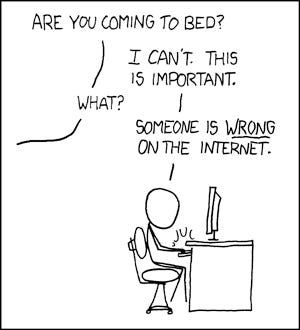Trigger Warnings and Mental Health
Are trigger warnings helpful, hurtful, or something else entirely?

I recently became an admin for a hyper-local, hyper-specific parenting Facebook group. As part of the gig, I have access to a private space for other admins of parenting groups in my area. This is where we share tips about avoiding bots, complain about Facebook, and rant about the unique trials and tribulations associated with being part of an online parenting space. One of the main reasons I wanted to admin in the first place was because, well, I just love some good low-stakes drama.
One admin concern that comes up again and again is the utility around trigger warnings (also known as content warnings) and whether or not specific topics warrant them.
Trigger warnings putatively allow someone to view at a glance what a longer post (or news article, or college lecture) is about, and to decide for themselves whether or not they want to engage with it. They were born from early feminist message boards to help provide readers agency about whether to engage with content that might remind them of personally-relevant trauma, particularly sexual assault.
The rationale for trigger warnings is to signal to an individual that subsequent content might be emotionally difficult to read if that individual has past experiences aligned with the content, allowing said individual to decide to just scroll right past without needing to read the full post (and get distressed in the process). Childhood illness or death, birth trauma, divorce, mental health difficulties, and fertility struggles are common topics that have trigger warnings in the online parenting groups I frequent.
Trigger warnings are in and of themselves a controversial topic [insert joke about having a trigger warning for trigger warnings here]. While some argue that they are evidence of the over-coddling of our society, others contend that they are essential in promoting a safe environment, particularly for those who have experienced trauma or are otherwise marginalized.
From a mental health perspective, there are compelling arguments for and against trigger warnings as they relate to trauma.1 Some may argue that trigger warnings help promote autonomy and reduce distress by providing people an opportunity to opt-out of content that might unduly upset them, especially in environments where they would rather not have to confront emotionally difficult material. On the other hand, maybe trigger warnings run counter to the core strategies that most treatments for PTSD recommend: Confronting one’s trauma and reducing one’s avoidance of aspects/situations related to that trauma.
Are trigger warnings helpful or harmful for our mental health?
In a recent meta-analysis published by Clinical Psychological Science, researchers examined all the studies that have attempted to understand how trigger warnings may (or may not) influence our emotions and behaviors.
The majority of studies they examined had a pretty basic structure: Participants were brought into a lab or completed the study online and were provided various content (films, images, text passages, etc.) Some content had a trigger warning that preceded it (e.g., “Trigger warning: This article contains content around domestic violence”; the experimental condition) while other content did not (the control condition). Participants then responded how distressed or negative they felt at various time points, and/or could choose not to engage with specific content. Most of these studies included at least some participants who had experienced trauma, with one study including only trauma survivors.
Overall, the researchers examined 12 studies that examined these outcomes related to trigger warnings. Here is what they found:
Trigger warnings have a neglible impact on how we feel after we engage with distressing material
Some studies found that trigger warnings caused more distress after people viewed content compared to the control conditions (i.e., no trigger warnings issued), while others found no differences or even that trigger warning reduced distress compared to control conditions. However, when all of the results were combined together, trigger warnings seemed to have very little influence one way or another on a person’s level of distress after engaging with potentially traumatic content.
Trigger warnings may increase negative emotions in anticipation of distressing material
Some studies not only assessed how negative a person felt after engaging with distressing material, but also assessed emotions people felt after getting a trigger warning but before viewing the main content. This allowed researchers to understand whether trigger warnings help people prepare for and regulate negative emotions, and possibly feel better due to their presence, or whether they increase distress, even before engaging with any difficult content.
Across studies, participants reported a slight increase in negative emotions after reading a trigger warning compared to when they did not receive any warning. Thus, trigger warnings do not seem to help us prepare to engage with difficult content.
Trigger warnings aren’t associated with avoiding distressing material
Surprisingly, people don’t seem to avoid content that have trigger warnings on them. Different studies assessed this in different ways, including allowing participants to “skip” or otherwise avoid content that came with a trigger warning, or assessing if/when participants dropped out of the study completely after a trigger warning was issued. So, even if someone gets a trigger warning, they are no more or less likely to read that news article, or watch that video, than if the content had no trigger warning.
Interestingly, one study even found that people were more likely to select content with a trigger warning, not less, compared to content that came with no trigger warnings.
Trigger warnings don’t affect how well people remember or comprehend material
This question of comprehension was particularly interesting to the researchers due to the ubiquity of trigger warnings in educational settings. Overall, whether or not material had an accompanying trigger warning did not appear to affect the amount of information people remembered after engaging with the potentially distressing content.
Summary
Taken together, neither the proponents nor critics of trigger warnings are completely in the right: Trigger warnings don’t seem to help us reduce distress, nor do they help us avoid distressing content. Sometimes they may even make us feel (slightly) worse.
Indeed, I found the idea that some people might engage with content more when it comes with a trigger warning really interesting. Honestly, I am that person, especially if a trigger warning is particularly incendiary or vague enough to engage my morbid curiosity.2 It’s nice to know that I’m not alone!
Trigger warnings don’t work. So now what?
If trigger warnings aren’t helpful or particularly harmful for our mental health, do they still have utility?
Honestly, I have complicated feelings about this.
Within a few years it feels like our culture has shifted dramatically, from people criticizing large corporations for doing only the most basic, self-serving types of inclusivity (I’m thinking about Pride merchandise at Target), to now, where the same large corporations have abandoned even the bare minimum (I’m thinking about, well, Target again). I did not think I would ever be nostalgic for performative diversity, equity, and inclusion, but here we are.
In our current reality I would rather be part of spaces where it is encouraged to discuss which topics warrant trigger warnings versus which ones don’t, compared to spaces where the incentive is to discard trigger warnings altogether. To me, seeing an online community with the cultural norm of using some type of trigger warning shows that it has intentions around fostering an environment of respect and empathy, where members are expected to take a beat as they write or scroll into the void and think about the perspectives of others.
At the same time, trigger warnings by themselves won’t create ideal communities. In practically every online space where trigger warnings exist, you will find self-righteous people who spend their precious free time policing whether others are doing trigger warnings “right,” which negates their intentions around fostering empathy.
Further, trigger warnings are not politically neutral, as they suggest what a specific community deems sensitive or inflammatory. I respect that some people don’t want to read about traumatic births or sexual assault, but I would be offended if someone requested that I put a trigger warning on a post about, say, the evidence behind vaccines, or gender non-conforming kids, or the existence of Palestine.3
Unfortunately, too many people confuse feeling uncomfortable with feeling unsafe. This can lead to white people saying they are “traumatized” if they are called out for their racist actions, or male perpetrators of sexual assault gaining more sympathy for their supposed loss of reputation or income than their victims. I don’t think trigger warnings always help with this aspect of our current culture.
Where do we go from here?
Trigger warnings are fairly new, and thus there is still much to understand empirically about them. The meta-analysis only included twelve studies and noted many blind spots in the literature, including the lack of studies that assess any potential cumulative effects of experiencing trigger warnings in daily life or that try to match content with personally relevant experiences (e.g., asking sexual assault survivors to view material relating specifically to their trauma). Further, negative emotions and distress are not synonymous with mental health symptoms; while some studies assessed symptoms like intrusive thoughts and anxiety, many did not, so it is unclear whether trigger warnings affect specific symptoms of trauma or aspects of other mental health conditions.
To my points above, it does not appear that any study to date has assessed how trigger warnings function in an existing community, online or not; their cultural value for specific groups; and their potential advantages (and disadvantages) in promoting inclusion and empathy.
In the meta-analysis, the researchers argue that one potential reason for the ineffectiveness of trigger warnings - they neither help us reduce distres nor avoid distressing content - is because the average person is just not very skilled at regulating their emotions. So, we might feel a small increase in distress when we see a trigger warning, but then we don’t really know how to cope with that distress.
Maybe instead of trigger warnings, we should have “emotion regulation reminders.” Are you engaging with something that upsets you? Try to label how you feel to better acknowledge and understand your emotions. Maybe focus on the less emotionally evocative aspects of the movie you’re watching or story you’re reading to help you manage your distress. Remind yourself that no emotion will last forever. Practice some paced breathing. Or even better, put your phone or computer away and take a break.
Trigger warnings don’t help us manage mental health challenges because, in the end, we are responsible for how we respond to things that make us feel uncomfortable. Trigger warnings can’t do that for us.
I doubt my “emotion regulation reminder” idea is going to become the next online sensation, but in the meantime: Don’t automatically assume that someone is being an asshole if they say something that hurts your feelings on social media. In turn, know that sometimes, even with the best intentions, the person being the asshole in the situation is you. If you’re called out for that, the best course of action is to acknowledge it, apologize, and do better next time.
And maybe brush up on some effective emotion regulation strategies that don’t involve yelling at people on the Internet.

The 5th edition of the Diagnostic and Statistical Manual of Mental Disorders (DSM-5) defines a traumatic event as a required criterion for a PTSD diagnosis, including exposure to death, threatened death, actual or threatened serious injury, or actual or threatened sexual violence. This exposure could be direct (the person experienced it themself) or indirect (the person witnessed the trauma occur to someone else; learned that it happened to someone close to them; or was exposed to details of different traumas as part of their professional duties, such as medics or first responders).
I really hate trigger warnings for things like “privilege,” because wtf does that mean, but it always activates my morbid curiosity, so I almost always read it anyways!
This latter point, and the heated disagreements about it, led to some of my online parenting groups simply imploding.





